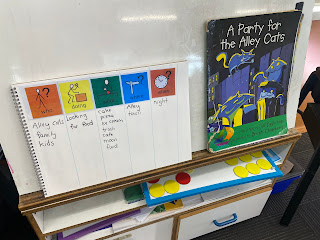A reflection of my journey - slideshow shows my progress this term as detailed in this blog post.
Introduction to SRSD
If you have been following any of my posts, you will know that my journey into evidence-based practice in all areas led me to SRSD (Self-Regulated Strategy Development) last year. I started to explore what I could find online and quickly realised that, even though I was only scratching the surface of what SRSD is, the impacts on my class's writing were obvious.
I listened to numerous podcasts and read as much as I could find, discovering that SRSD truly fits the bill for an evidence-based approach to writing. I must preface this by saying that I am not an expert; my qualifications lie in my commitment to using best practices and making this work in a typical New Zealand classroom.
Professional Learning Development (PLD) with ThinkSRSD
As a staff, we collectively decided to undertake Professional Learning Development (PLD) in ThinkSRSD. Our goal is to develop a shared learning language across the school. This is a year-long commitment, but it has been encouraging to see classes engaging in both collaborative and independent writing already. We are working through this in bite sized amounts at staff meetings and trying as we go along. This allows us to reflect on how things are going, share our practice and assist each other to iron out any issues as we go. SRSD will be a wonderful addition to our approach when using the Science of Literacy. We can see the benefits it will have for both reading and writing.
The Importance of Colourful Semantics
If you have read any of my other posts on writing, you will know that I greatly value colourful semantics as a framework for building sentences. Much of what I have learned over the years has returned to sentence-level construction. Writing, like all areas of learning, is a skill built on many pieces of understanding that must come together to form the 'end' product we eventually see.Rethinking Writing Instruction
| Certainly not an exhaustive list of skills that it takes to be a writer, but these are the many things that go into the process of growing into a writer. |
Writing is one of the most cognitively complex processes we ask children to undertake. I have come to realise that it has only been in the last four or five years that my practice has started to reflect this fact. For too long, my approach was based on the simplistic notion that we get better at writing by writing. I have learned that this overlooks the necessity of deliberately building the foundational skills children need to write effectively.
Colourful semantics, developing the foundations of writing and the building of complete sentences form the bedrock of our initial approach to writing, and this became my starting point for this year's instruction.
Once I felt that the children had a good understanding of what a detail is, we transitioned into using our reading sessions to gather these details. If you are familiar with our whole-class reading approach, you will know that our character stories play a significant role in this process.
I introduced TIDE to the children, and we learned each part of this mnemonic. We then read our character stories and analysed them using TIDE, identifying our topic sentence, important details, and ending. For now, ID will be used together.
From here I wanted to use the character stories we did have, to write a piece collaboratively about our farm friends. In order to do this, I needed to introduce POW.
Moving Into Term Two
Moving into Term 2, I will gradually scaffold the children into independence. We have introduced the character Vog in our stories, so I will create a character bio and additional materials to help them learn about Vog. We will then work through a POWER cycle together. We will plan with TIDE, write the topic sentence collaboratively, and then allow them to develop the details independently. Finally, we will write a conclusion that we are all happy with.
Next term, I will also introduce the assessment aspect using the rocket. Initially, we will examine the "Farm Friends" story we have written, analyse it using TIDE, and then assess it with the rocket. My students loved this activity last year.
For Term 2, our knowledge spine will focus on sea creatures, both past and present, as well as magnetism and flight. As the term progresses, we will gradually build our knowledge by reading texts and working through the POWER cycle, organising with TIDE.
I also plan to introduce CSPACE as a method for analysing narratives. We will see how this goes.
I love the SRSD process as it provides a strong framework for children's writing and can be applied across all year levels. I am eager to see the impact it will have on our writing over the next 3 to 5 years. I particularly appreciate the self-talk component of SRSD, which we have been specifically teaching through handwriting.






















No comments:
Post a Comment